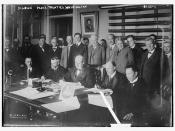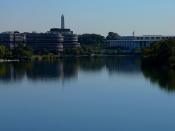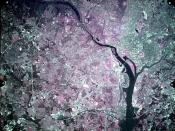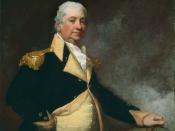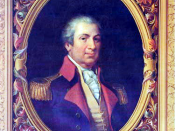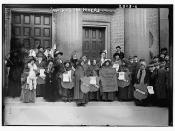Henry Knox was born on July 25, 1750 in Boston, Massachusetts. He was the son to William and Mary Campbell Knox. His parents were both pioneers from Northern Ireland. Henry was the seventh of ten children. William Knox was a shipmaster that traded among the West Indies. He suffered from money difficulties and mental stress, passing away at the age of fifty. Because of this, Henry gave up school and became the sole support for his mother.1 At the age of 12, he was employed by a Boston bookseller. Then in 1771, he opened his own shop, the London Bookstore, which became a gathering place for British officers.2 This position that allowed him to acquire a considerable part of his education. He read much of Plutarch and learned of ancient heroes, of military tactics and strategy, and became knowledable in military science.3Henry Knox joined a local military group when he was 18.
He supported the American cause, and in 1772, he became a member of the Boston Grenadier Corps. He was prominent in the colonial militia and tried to keep the Boston citizenry and British soldiers from the clash known as the Boston Massacre. He was a volunteer in June 1775 at the Battle of Bunker Hill. He served under General Ward, in charge of the colonials around Boston.4 In 1775, Washington arrived in Boston, taking command of the army. It was here where Washington developed a friendship with Knox. Washington realized the need of artillery in the American forces and found Knox to be well educated on the subject. Washington asked his opinion on what the army should do. The thought of Knox was to use the cannons from the captured Fort Ticonderoga. Knox was commissioned a colonel, placed in charge of artillery, and given the task to bring cannons from Ticonderoga to Boston. During this time it was winter and the conditions were harsh. By the way of ox sleds, Knox successfully brought fifty cannons to the city of Boston.5In March 1776, Washington seized Dorchester Heights, which was the key to Boston, and Knox placed the cannons in position there. General Howe, an English general, realizing the danger of an impending American attack, withdrew his troops from the city. On March 17, he embarked his troops for Halifax. The Americans entered Boston and claimed the city.4After the capture of Boston, Knox helped place Connecticut and Rhode Island in proper defense, in preparation for the return of the British. Washington took his forces to defend New York. Knox joined the army there, as the British fleet arrived in New York, with about 30,000 men. The American forces had about 18,000 men with very little experience. Knox had 520 officers and soldiers to handle approximately 120 cannons with very little experience.6 The American forces were so outnumbered, they were forced to retreat across the Delaware River at Trenton on December 8, 1776. The Americans had seized all the boats along the Delaware, so the British were unable to follow. With reduced forces, who were poorly clothed and armed, the American troops were depressed. Washington did not give up hope, and Knox followed his lead. It was on Christmas night that Washington made his famous trip across the Delaware, directed by Knox, to surprise the Hessian forces at Trenton. They captured 1000 men as well as supplies. The American army of 2500, the captives and supplies were all carried back across the Delaware. 2 This event gave a much needed boost to the American morale. Knox, himself, was promoted to brigadier-general as a result of his service.
Washington was now in a position to make another strike against the British. The army crossed the Delaware once more into New Jersey. Cornwallis withdrew a portion of his troops and pursued Washington. Washington was located between the Delaware and Trenton. Thinking the Americans were trapped, Cornwallis planned their capture for the morning. Washington had other plans and the Americans built blazing fires to deceive the British and made their escape, marching to Princeton. On January 3, 1777, Washington attacked the British army, but they were driven back. Washington rallied the troops...and the British were driven back and defeated. Knox and his men rendered aggressive service, earning him a commendation from the Commander-in-Chief.6Knox had a commission while the army was in winter quarters at Morristown. He was sent to Massachusetts to raise a battalion for the artillery. He was also given the task of creating an arsenal, and Knox did at Springfield. It became a valuable source in the production and repair of arms for the remaining years of the Revolution.5Knox was involved in fighting at both the battles of Brandywine and Germantown. He had a limited number of cannons. At Brandywine he placed them near Chadds Ford, but the British forced a retreat. The Americans held them in check at Birmingham Meeting House and were able to retreat to Chester.2At Valley Forge, Knox was invaluable in organizing and erecting forts to safeguard the winter encampment from British attack. Knox was given permission to leave Valley Forge for a time to visit his family in Massachusetts, but particularly to speed supplies for the army from the New England states. Knox returned and immediately began to assist Steuben in his drilling of the troops, particularly the artillery men.6 The troops left Valley Forge on June 19 and headed for battle at Monmouth.
Later, Knox was sent as a representative of Washington to secure aid from the northern states in what Washington hoped would be the last campaign of the war. January 1, 1781, from New Windsor, Washington wrote Knox: "You will generally represent to the supreme executive powers of the States, through which you pass, and to gentlemen of influence in them, the alarming crisis to which our affairs have arrived, by a too long neglect of measures essential to the existence of the army, and you may assure them, that, if a total alteration of system does not take place in paying, clothing and feeding the troops, it will be in vain to expect a continuance of their service in another campaign."6 Knox was successful.
Eventually, the British army was forced in siege at Yorktown. Knox had placed the artillery in fine strategic position. After the surrender of General Cornwallis of the English army on October 19, 1781, Knox was advanced to the position of major-general.1In 1782, Knox was stationed at West Point and remained there with the troops until the agreement was made for the British to evacuate New York. In the fall of 1783, Knox was able to leave as they followed the British out of New York. On December 4, the officers assembled at Fraunces Tavern to take final leave of their Commander-in-Chief. Knox stood by Washington. Washington withdrew and Knox returned to Boston.3Henry Knox was elected Secretary of War by Congress in 1785, and in 1789 he was appointed Secretary of War in President Washington's new cabinet and the first Secretary of War leader. Knox found his service as Secretary of War to deal with growing unrest in the western frontier of the backcountry. When a treaty was finally reached, the leadership of Knox was manifested in his aid in promoting law and order.4On December 28, 1794, Henry Knox resigned from office. Washington accepted Knox's resignation with regret. Timothy Pickering, who was Postmaster General at this time, was appointed the successor to Knox as Secretary of War and took office January 2, 1795.1 General Knox and his family settled on an estate at Thomaston, Maine in 1796, which he called "Montpelier." He was engaged in various types of businesses during the later part of his life such as brick-making, cattle-raising and ship-building. He entertained crowds at his mansion where he always loved good food and people. He gave some time in service to his state in General Court and Governor's Council. Washington desired to appoint Knox as a Commissioner to St. Croix, but Knox declined.6Knox died unexpectedly on October 26, 1806.1 The cause of death was a chicken bone that was lodged in his intestines and caused internal inflammation.7 He was buried in Thomaston.
NOTES1. Encyclopedia Brittanica, 2000 ed., s.v. "Knox, Henry."2. Ronald W. McGranahan., "Major General Henry Knox," [http://www.dell.homestead.com/revwar/files/KNOX.HTM], 1998-993. WISDOM LODGE No. 202 F. & A.M., "Henry W Knox," [http://www.wisdomlodge202.org/names.htm].
4. Funk & Wagnalls New Encyclopedia. s.v. "Knox, Henry," ed. Robert J. Phillips (The Dun & Bradstreet Corporation), 15:28, 283.
5. Compton's Interactive Encyclopedia., 1998 ed., s.v. "Knox, Henry."6. The Friends of Fort Knox, "Fort Knox History," [http://fortknox.maineguide.com], 2000.
7. Richard Ferrie, "Bio: Henry Knox," [http://www.richardferrie.com/hk.htm], 1999.
BibliographyCompton's Interactive Encyclopedia., 1998 ed., s.v. "Knox, Henry."Encyclopedia Brittanica, 2000 ed., s.v. "Knox, Henry."Ferrie, Richard (rdf@richardferrie.com), "Bio: Henry Knox,"[http://www.richardferrie.com/hk.htm], 1999.
Funk & Wagnalls New Encyclopedia. s.v. "Knox, Henry," ed. Robert J. Phillips, The Dun & Bradstreet Corporation, 15:28.
McGranahan, Ronald W., "Major General Henry Knox,"[http://www.dell.homestead.com/revwar/files/KNOX.HTM], 1998-99.
The Friends of Fort Knox (FOFK1@aol.com )"Fort Knox History,"[http://fortknox.maineguide.com], 2000.
WISDOM LODGE No. 202 F. & A.M., "Henry W Knox,"[http://www.wisdomlodge202.org/names.htm].
